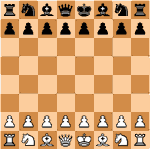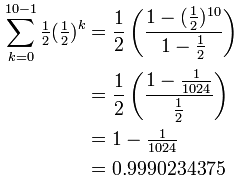that works for any sequence.
Example: the sequence {3, 5, 7, 9, ...}
We have just shown a Rule for {3, 5, 7, 9, ...} is:
2n+1
And so we get: {3, 5, 7, 9, 11, 13, ...}
But can we find another rule?
How about
"odd numbers without a 1 in them":
And we get: {3, 5, 7, 9, 23, 25, ...}
A completely different sequence!
And we could find more rules that match
{3, 5, 7, 9, ...}. Really we could.
So it is best to say "A Rule" rather then "The Rule" (unless we know it is the right Rule)
Now let's look at some special sequences, and their rules.
.
In other words, we just add some value each time ... on to infinity.
{a, a+d, a+2d, a+3d, ... }
Geometric Sequences and Sums
Sequence
A Sequence is a set of things (usually numbers) that are in order.
Geometric Sequences
In a
Geometric Sequence each term is found by
multiplying the previous term by a
constant.
Example:
| 1, 2, 4, 8, 16, 32, 64, 128, 256, ... |
This sequence has a factor of 2 between each number.
Each term (except the first term) is found by multiplying the previous term by 2.
In General we write a Geometric Sequence like this:
{a, ar, ar2, ar3, ... }
where:
- a is the first term, and
- r is the factor between the terms (called the "common ratio")
Example: {1,2,4,8,...}
The sequence starts at 1 and doubles each time, so
- a=1 (the first term)
- r=2 (the "common ratio" between terms is a doubling)
And we get:
{a, ar, ar2, ar3, ... }
= {1, 1×2, 1×22, 1×23, ... }
= {1, 2, 4, 8, ... }
But be careful, r should not be 0:
- When r=0, we get the sequence {a,0,0,...} which is not geometric
The Rule
We can also calculate
any term using the Rule:
xn = ar(n-1)
(We use "n-1" because ar0 is for the 1st term)
Example:
| 10, 30, 90, 270, 810, 2430, ... |
This sequence has a factor of 3 between each number.
The values of
a and
r are:
- a = 10 (the first term)
- r = 3 (the "common ratio")
The Rule for any term is:
xn = 10 × 3(n-1)
So, the
4th term is:
x4 = 10×3(4-1) = 10×33 = 10×27 = 270
And the
10th term is:
x10 = 10×3(10-1) = 10×39 = 10×19683 = 196830
A Geometric Sequence can also have
smaller and smaller values:
Example:
This sequence has a factor of 0.5 (a half) between each number.
Its Rule is xn = 4 × (0.5)n-1
Why "Geometric" Sequence?
Because it is like increasing the dimensions in
geometry:
 | a line is 1-dimensional and has a length of r |
| in 2 dimensions a square has an area of r2 |
| in 3 dimensions a cube has volume r3 |
| etc (yes we can have 4 and more dimensions in mathematics). |
Geometric Sequences are sometimes called Geometric Progressions (G.P.’s)
Summing a Geometric Series
When we need to sum a Geometric Sequence, there is a handy formula.
To sum:
a + ar + ar2 + ... + ar(n-1)
Each term is ark, where k starts at 0 and goes up to n-1
Use this formula:
 a
a is the first term
r is the
"common ratio" between terms
n is the number of terms
 | (called Sigma) means "sum up" |
And below and above it are shown the starting and ending values:
It says "Sum up n where n goes from 1 to 4. Answer=10
The formula is easy to use ... just "plug in" the values of
a,
r and
n
Example: Sum the first 4 terms of
| 10, 30, 90, 270, 810, 2430, ... |
This sequence has a factor of 3 between each number.
The values of
a,
r and
n are:
- a = 10 (the first term)
- r = 3 (the "common ratio")
- n = 4 (we want to sum the first 4 terms)
So:
Becomes:
You can check it yourself:
10 + 30 + 90 + 270 = 400
And, yes, it is easier to just add them
in this example, as there are only 4 terms. But imagine adding 50 terms ... then the formula is much easier.
Using the Formula
Let's see the formula in action:
Example: Grains of Rice on a Chess Board
On the page
Binary Digitswe give an example of grains of rice on a chess board. The question is asked:
When we place rice on a chess board:
- 1 grain on the first square,
- 2 grains on the second square,
- 4 grains on the third and so on,
- ...
... doubling the grains of rice on each square ...
... how many grains of rice in total?
So we have:
- a = 1 (the first term)
- r = 2 (doubles each time)
- n = 64 (64 squares on a chess board)
So:
Becomes:
= 1−264−1 = 264 − 1
= 18,446,744,073,709,551,615
Which was exactly the result we got on the
Binary Digits page (thank goodness!)
And another example, this time with
r less than 1:
Example: Add up the first 10 terms of the Geometric Sequence that halves each time:
{ 1/2, 1/4, 1/8, 1/16, ... }
The values of
a,
r and
n are:
- a = ½ (the first term)
- r = ½ (halves each time)
- n = 10 (10 terms to add)
So:
Becomes:
Very close to 1.
(Question: if we continue to increase n, what happens?)
Why Does the Formula Work?
Let's see
why the formula works, because we get to use an interesting "trick" which is worth knowing.
First, call the whole sum "S": S = a + ar + ar2 + ... + ar(n−2)+ ar(n−1)
Next, multiply S by r:S·r = ar + ar2 + ar3 + ... + ar(n−1) + arn
Notice that S and S·r are similar?
Now subtract them!
Wow! All the terms in the middle neatly cancel out.
(Which is a neat trick)
By subtracting
S·r from
S we get a simple result:
Let's rearrange it to find
S:
Factor out S and a:S(1−r) = a(1−rn)
Divide by (1−r):S = a(1−rn)(1−r)
Which is our formula (ta-da!):
Infinite Geometric Series
So what happens when
n goes to infinity?
Well ... when r is less than 1, then rn goes to zeroand we get:
NOTE: this does not work when
r is 1 or more (or less than -1):
r must be between (but not including) -1 and 1
and r should not be 0 because we get the sequence {a,0,0,...} which isn't geometric
Let's bring back our previous example, and see what happens:
Example: Add up ALL the terms of the Geometric Sequence that halves each time:
{ 12, 14, 18, 116, ... }
We have:
- a = ½ (the first term)
- r = ½ (halves each time)
And so:
= ½×1½ = 1
Yes, adding
12 + 14 + 18 + ... etc equals
exactly 1.
Don't believe me? Just look at this square:
By adding up 12 + 14 + 18 + ...
we end up with the whole thing! | |  |
Recurring Decimal
On another page we asked
"Does 0.999... equal 1?", well, let us see if we can calculate it:
Example: Calculate 0.999...
We can write a recurring decimal as a sum like this:
And now we can use the formula:
Yes! 0.999...
does equal 1.
Example:
| 2, 4, 8, 16, 32, 64, 128, 256, ... |
This sequence has a factor of 2 between each number.
Its Rule is xn = 2n
In General we can write a geometric sequence like this:
{a, ar, ar2, ar3, ... }
where:
- a is the first term, and
- r is the factor between the terms (called the "common ratio")
Note: r should not be 0.
- When r=0, we get the sequence {a,0,0,...} which is not geometric
And the rule is:
xn = ar(n-1)
(We use "n-1" because ar0 is the 1st term)
Triangular Numbers
| 1, 3, 6, 10, 15, 21, 28, 36, 45, ... |
The
Triangular Number Sequence is generated from a pattern of dots which form a triangle:
By adding another row of dots and counting all the dots we can find the next number of the sequence.
But it is easier to use this Rule:
xn = n(n+1)/2
Example:
- the 5th Triangular Number is x5 = 5(5+1)/2 = 15,
- and the sixth is x6 = 6(6+1)/2 = 21
Square Numbers
| 1, 4, 9, 16, 25, 36, 49, 64, 81, ... |
The next number is made by squaring where it is in the pattern.
Rule is xn = n2
Cube Numbers
| 1, 8, 27, 64, 125, 216, 343, 512, 729, ... |
The next number is made by cubing where it is in the pattern.
Rule is xn = n3
Fibonacci Sequence
This is the
Fibonacci Sequence
| 0, 1, 1, 2, 3, 5, 8, 13, 21, 34, ... |
The next number is found by
adding the two numbers before it together:
- The 2 is found by adding the two numbers before it (1+1)
- The 21 is found by adding the two numbers before it (8+13)
- etc...
Rule is xn = xn-1 + xn-2
That rule is interesting because it depends on the values of the previous two terms.
Rules like that are called recursive formulas.
The Fibonacci Sequence is numbered
from 0 onwards like this:
| n = | 0 | 1 | 2 | 3 | 4 | 5 | 6 | 7 | 8 | 9 | 10 | 11 | 12 | 13 | 14 | ... |
| xn= | 0 | 1 | 1 | 2 | 3 | 5 | 8 | 13 | 21 | 34 | 55 | 89 | 144 | 233 | 377 | ... |
Example: term "6" is calculated like this:
x6 = x6-1 + x6-2 = x5 + x4 = 5 +



















